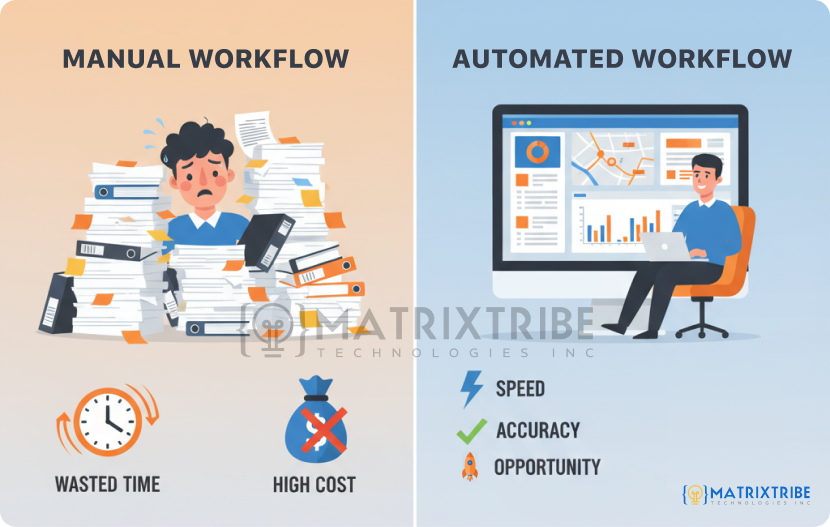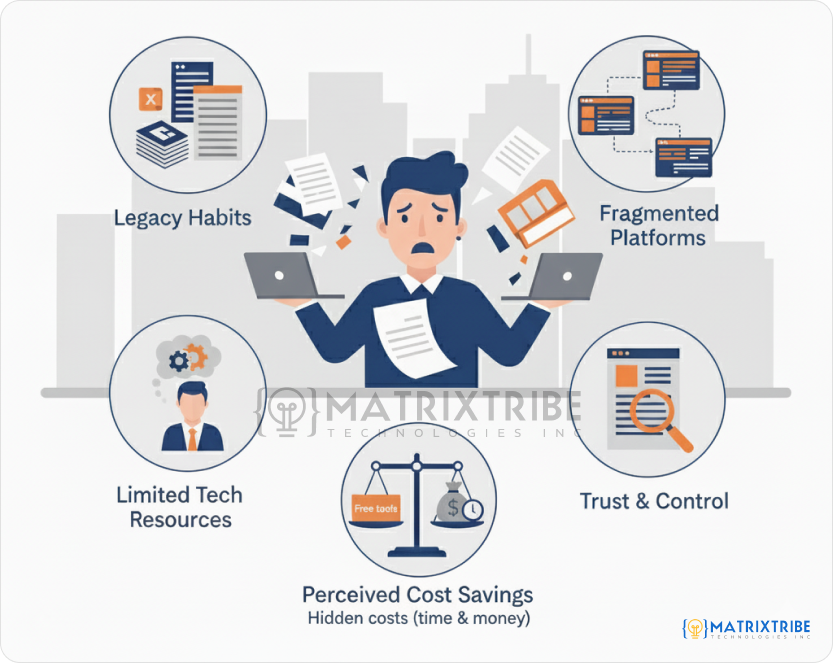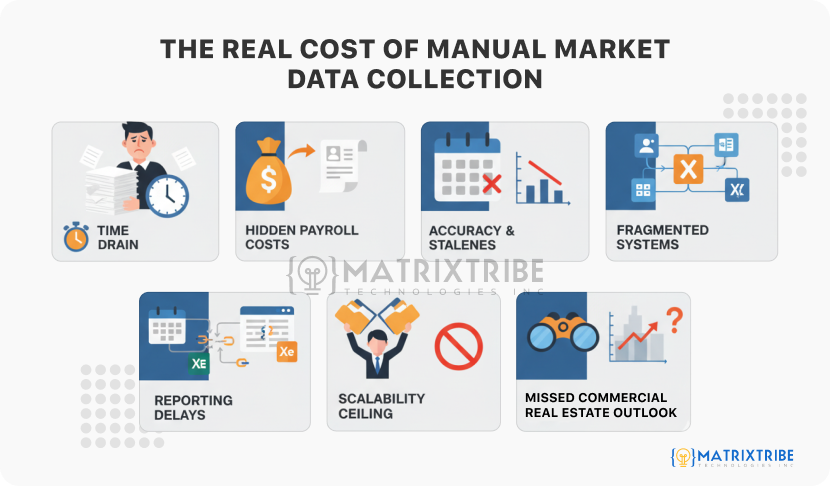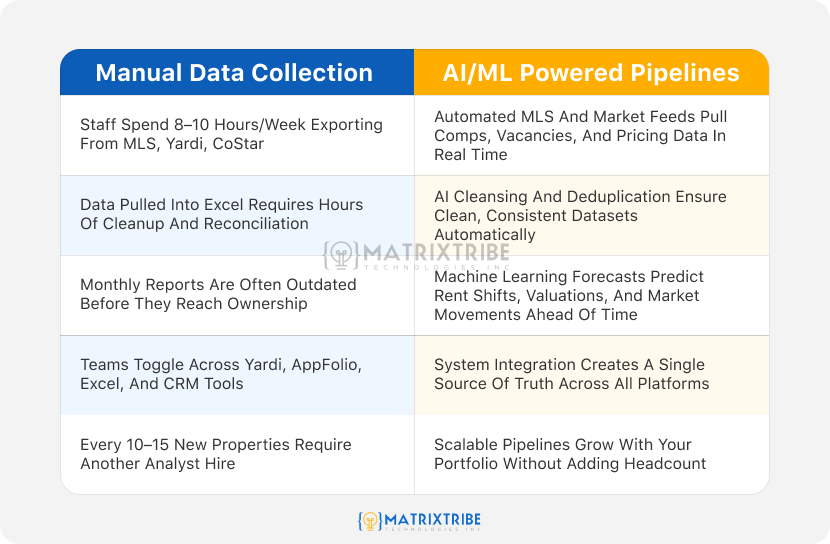

Real Estate
The Hidden Cost of Manual Data Collection in Real Estate
September 29, 2025
BLOG
The Hidden Cost of Manual Data Collection in Real Estate
Manual data collection may seem like a simple task for property managers, but its hidden costs stack up quickly. From wasted hours and payroll drag to stale comps, reporting delays, and scalability ceilings, manual workflows quietly hold portfolios back. This article breaks down the true cost of manual collection and shows how AI- and ML-powered data pipelines replace outdated processes with real-time insights.
Real estate teams spend countless hours each week manually pulling rental comps and reconciling fragmented data records. This repetitive workflow is not only frustrating, it's expensive. The time spent manually collecting data can be best spent doing productive tasks.
In a market where timing and accuracy drive margins, relying on manual data collection means you're not just losing hours, you're losing opportunities. Let's blog unpacks the hidden cost of manual workflows in real estate and shows how automation and real-time data pipelines turn wasted effort into a competitive advantage.

Why Real Estate Teams Still Rely on Manual Data Collection
Even at the end of 2025, many property managers still seem to be trapped in manual workflows, copying from one portal to another just to get a clear picture of the market.
Legacy Habits
Manual data collection has been a standard in the real estate market. Most property managers are used to pulling data directly from MLS databases, downloading major listings into Excel, or even running a quick MLS house search whenever comps are needed. Manual collection from real estate websites or even a quick Zillow scraper feels faster in the moment, even though it consumes hours every week.
Fragmented Platforms
Property managers rarely have a single system of record. They juggle real estate CRM software, accounting tools, and analytics platforms. With no seamless way to integrate reports across real estate valuation models, commercial real estate data, and internal spreadsheets, teams are forced to stitch together insights manually.
Limited Tech Resources
Many PMs think they need dedicated analysts to automate real estate market analysis. Hence, they rely on spreadsheets and exports to make sense of the real estate market trends. This DIY approach may work for a single property, but it doesn't scale to an entire portfolio.
Perceived Cost Savings
On paper, manual collection looks free. The staff already on payroll pulls comps from free real estate comps tools or searches MLS databases. But the real cost shows up in payroll hours, delayed housing market predictions, and missed opportunities in today's fast-moving housing market.
Trust and Control
Some managers still feel safer manually reviewing listings, believing that "if I collect the data myself, I can trust it." Even though this slows reporting, it feels like a safeguard against bad data when they're responsible for explaining commercial real estate values or presenting a housing market graph to owners.

The Real Cost of Manual Market Data Collection
Manual data collection might seem harmless when it's just a few MLS exports or Excel sheets, but for property managers, the hidden costs add up quickly. From wasted hours to stale reports, here's where manual processes take the biggest toll:
Time Drain
Manual data collection eats up a workday every week when PMs spend hours exporting reports, scraping listings, and combining comps. What feels like a quick download often adds up to a full workday lost, for property managers, which translates into a significant weekly drag on productivity.
Hidden Payroll Costs
Those hours aren't free. The salary you pay your analysts isn't just for pulling reports. Yet when a quarter of their week goes into manual data collection, the true cost is hidden in lost productivity. Multiply that across a property management team, and what looks like routine admin work can quietly become one of the firm's largest ongoing expenses.
Accuracy and Staleness
By the time monthly exports from Yardi or AppFolio are reconciled against MLS or CoStar, the market has often shifted. Listings expire, rents adjust, and comps move faster than manual cycles can keep up. Research shows that around 30% of business data becomes outdated each year, meaning property managers may be presenting owners with stale reports before they're even finalized.
Fragmented Systems
Most property managers are working in silos. The financials in Yardi, tenant data in AppFolio, comps in CoStar, and everything tied together in Excel. With no integration, PMs have to manually collect, match, and reconcile each dataset. A Quickbase survey found nearly 70% of employees spend 20+ hours a week chasing information across disconnected systems. For PMs, that means fragmented systems directly drain staff time and attention.
Reporting Delays
Manual collection almost always runs on a monthly cycle, which means stakeholders wait weeks for visibility into performance. By the time the data is compiled, it's often outdated. These slow cycles end up creating friction with owners demanding real-time insights.
Scalability Ceiling
Manual collection doesn't scale. For every 10–15 new properties, firms often add another analyst just to keep up with reporting. One case study estimates that property managers with 100 properties spend around 300,000 dollars a year on manual market surveys. That scalability ceiling means portfolio growth is tied to headcount instead of opportunity.
Missed Commercial Real Estate Outlook
Manual collection keeps property managers focused on the past, not the present. By the time teams pull MLS exports, reconcile reports from Yardi or AppFolio, and update spreadsheets, the broader real estate market trends have already shifted.
This lack of visibility means firms struggle to provide ownership with a clear picture of the commercial real estate outlook. Without automated feeds, managers can only report what has happened, not what is happening, leaving decision-makers blind to emerging opportunities or risks in the market.

Automation Changes the Game: From Manual to Real-Time
Property managers don't rely on manual data collection because they want to; they do it because it feels like the only option. But the hidden costs are clear: lost time, delayed reporting, stale comps, and a ceiling on how far portfolios can scale.
AI/ML-Powered Pipelines in Practice
Instead of analysts spending hours exporting from MLS, CoStar, or Yardi, you should opt for real estate data pipelines that automate the entire process. Here's what that means in practice:
Automated MLS and Market Feeds
Real-time integrations with MLS databases and listing sites pull fresh comps, vacancies, and pricing data continuously, eliminating the lag of monthly manual collection.
Cleansing and Deduplication with AI
AI models standardize and clean incoming data, removing duplicates and filling gaps. Property managers get consistent, reliable reports without hours of spreadsheet reconciliation.
Forecasting with Machine Learning
ML algorithms don't just capture today's data; they predict rent adjustments, valuations, and market movements ahead of time. Hence, giving you a forward-looking edge.
Cross System Integration
An AI-powered real estate data intelligence pipeline can connect all your systems to provide a unified view. Whether your firm runs Yardi, AppFolio, Excel, or CRM tools, the dashboard can show all the data in one place. No more toggling across platforms or chasing fragmented datasets.

The MatrixTribe Way: Turning Data into Decisions
At MatrixTribe Technologies, we believe property managers shouldn't be wasting hours every week exporting reports or stitching spreadsheets together. Our approach is simple: we design custom artificial intelligence and machine learning powered data pipelines that connect your systems, automate collection, and deliver clean, real-time reporting. Instead of reacting to outdated snapshots, you get forward-looking insights you can trust.
What makes our approach different is that it's built for property management realities, not generic SaaS templates. We integrate directly with the tools you already use and transform them into a single, scalable source of truth. As your portfolio grows, the pipeline grows with it, without the hidden payroll costs or reporting delays that come with manual collection.
Manual collection is yesterday's process. With MatrixTribe, you get a pipeline that never sleeps and a partner that makes sure you're always a step ahead of the market.
Final Words
For property managers, manual data collection feels routine, a few MLS exports here, an AppFolio report there. But add up the hours, the payroll drags, the stale comps, and the reporting delays, and the true cost becomes impossible to ignore. In today's fast-moving real estate market, clinging to manual workflows doesn't just waste resources; it holds portfolios back from scaling.
Ready to Stop Collecting and Start Competing?
At MatrixTribe Technologies, we build AI- and ML-powered data pipelines that eliminate manual collection, deliver real-time insights, and give property managers the tools to grow without limits.
If your team is ready to trade spreadsheets for speed, talk to us today about building a pipeline that scales with your business.

Latest Article




